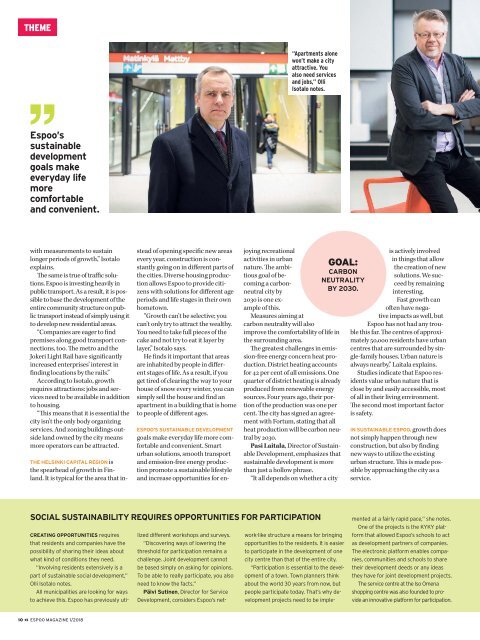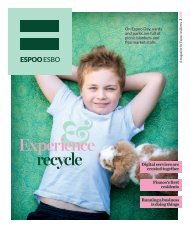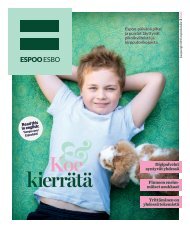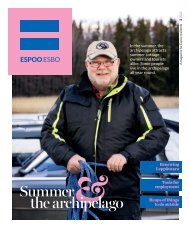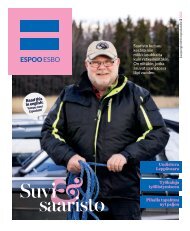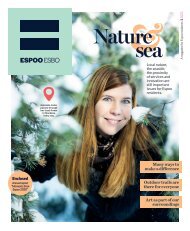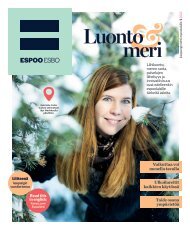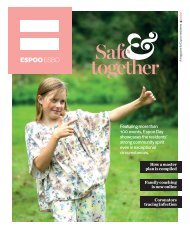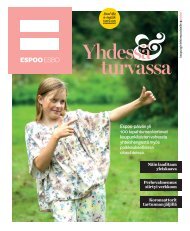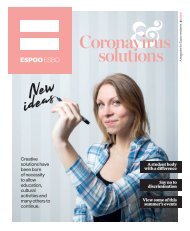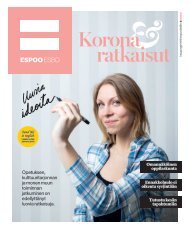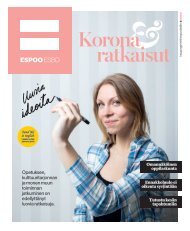ESPOO MAGAZINE 1/2018
A MAGAZINE FOR ESPOO RESIDENTS
A MAGAZINE FOR ESPOO RESIDENTS
Create successful ePaper yourself
Turn your PDF publications into a flip-book with our unique Google optimized e-Paper software.
THEME<br />
<br />
Espoo’s<br />
sustainable<br />
development<br />
goals make<br />
everyday life<br />
more<br />
comfortable<br />
and convenient.<br />
“Apartments alone<br />
won’t make a city<br />
attractive. You<br />
also need services<br />
and jobs,” Olli<br />
Isotalo notes.<br />
with measurements to sustain<br />
longer periods of growth,” Isotalo<br />
explains.<br />
The same is true of traffic solutions.<br />
Espoo is investing heavily in<br />
public transport. As a result, it is possible<br />
to base the development of the<br />
entire community structure on public<br />
transport instead of simply using it<br />
to develop new residential areas.<br />
“Companies are eager to find<br />
premises along good transport connections,<br />
too. The metro and the<br />
Jokeri Light Rail have significantly<br />
increased enterprises’ interest in<br />
finding locations by the rails.”<br />
According to Isotalo, growth<br />
requires attractions: jobs and services<br />
need to be available in addition<br />
to housing.<br />
“This means that it is essential the<br />
city isn’t the only body organizing<br />
services. And zoning buildings outside<br />
land owned by the city means<br />
more operators can be attracted.<br />
THE HELSINKI CAPITAL REGION is<br />
the spearhead of growth in Finland.<br />
It is typical for the area that instead<br />
of opening specific new areas<br />
every year, construction is constantly<br />
going on in different parts of<br />
the cities. Diverse housing production<br />
allows Espoo to provide citizens<br />
with solutions for different age<br />
periods and life stages in their own<br />
hometown.<br />
“Growth can’t be selective; you<br />
can’t only try to attract the wealthy.<br />
You need to take full pieces of the<br />
cake and not try to eat it layer by<br />
layer,” Isotalo says.<br />
He finds it important that areas<br />
are inhabited by people in different<br />
stages of life. As a result, if you<br />
get tired of clearing the way to your<br />
house of snow every winter, you can<br />
simply sell the house and find an<br />
apartment in a building that is home<br />
to people of different ages.<br />
<strong>ESPOO</strong>’S SUSTAINABLE DEVELOPMENT<br />
goals make everyday life more comfortable<br />
and convenient. Smart<br />
urban solutions, smooth transport<br />
and emission-free energy production<br />
promote a sustainable lifestyle<br />
and increase opportunities for enjoying<br />
recreational<br />
activities in urban<br />
nature. The ambitious<br />
goal of becoming<br />
a carbonneutral<br />
city by<br />
2030 is one example<br />
of this.<br />
Measures aiming at<br />
carbon neutrality will also<br />
improve the comfortability of life in<br />
the surrounding area.<br />
The greatest challenges in emission-free<br />
energy concern heat production.<br />
District heating accounts<br />
for 42 per cent of all emissions. One<br />
quarter of district heating is already<br />
produced from renewable energy<br />
sources. Four years ago, their portion<br />
of the production was one per<br />
cent. The city has signed an agreement<br />
with Fortum, stating that all<br />
heat production will be carbon neutral<br />
by 2030.<br />
Pasi Laitala, Director of Sustainable<br />
Development, emphasizes that<br />
sustainable development is more<br />
than just a hollow phrase.<br />
“It all depends on whether a city<br />
GOAL:<br />
CARBON<br />
NEUTRALITY<br />
BY 2030.<br />
is actively involved<br />
in things that allow<br />
the creation of new<br />
solutions. We succeed<br />
by remaining<br />
interesting.<br />
Fast growth can<br />
often have negative<br />
impacts as well, but<br />
Espoo has not had any trouble<br />
this far. The centres of approximately<br />
50,000 residents have urban<br />
centres that are surrounded by single-family<br />
houses. Urban nature is<br />
always nearby,” Laitala explains.<br />
Studies indicate that Espoo residents<br />
value urban nature that is<br />
close by and easily accessible, most<br />
of all in their living environment.<br />
The second most important factor<br />
is safety.<br />
IN SUSTAINABLE <strong>ESPOO</strong>, growth does<br />
not simply happen through new<br />
construction, but also by finding<br />
new ways to utilize the existing<br />
urban structure. This is made possible<br />
by approaching the city as a<br />
service.<br />
SOCIAL SUSTAINABILITY REQUIRES OPPORTUNITIES FOR PARTICIPATION<br />
CREATING OPPORTUNITIES requires<br />
that residents and companies have the<br />
possibility of sharing their ideas about<br />
what kind of conditions they need.<br />
“Involving residents extensively is a<br />
part of sustainable social development,”<br />
Olli Isotalo notes.<br />
All municipalities are looking for ways<br />
to achieve this. Espoo has previously utilized<br />
different workshops and surveys.<br />
“Discovering ways of lowering the<br />
threshold for participation remains a<br />
challenge. Joint development cannot<br />
be based simply on asking for opinions.<br />
To be able to really participate, you also<br />
need to know the facts.”<br />
Päivi Sutinen, Director for Service<br />
Development, considers Espoo’s network-like<br />
structure a means for bringing<br />
opportunities to the residents. It is easier<br />
to participate in the development of one<br />
city centre than that of the entire city.<br />
“Participation is essential to the development<br />
of a town. Town planners think<br />
about the world 30 years from now, but<br />
people participate today. That’s why development<br />
projects need to be implemented<br />
at a fairly rapid pace,” she notes.<br />
One of the projects is the KYKY platform<br />
that allowed Espoo’s schools to act<br />
as development partners of companies.<br />
The electronic platform enables companies,<br />
communities and schools to share<br />
their development deeds or any ideas<br />
they have for joint development projects.<br />
The service centre at the Iso Omena<br />
shopping centre was also founded to provide<br />
an innovative platform for participation.<br />
10


